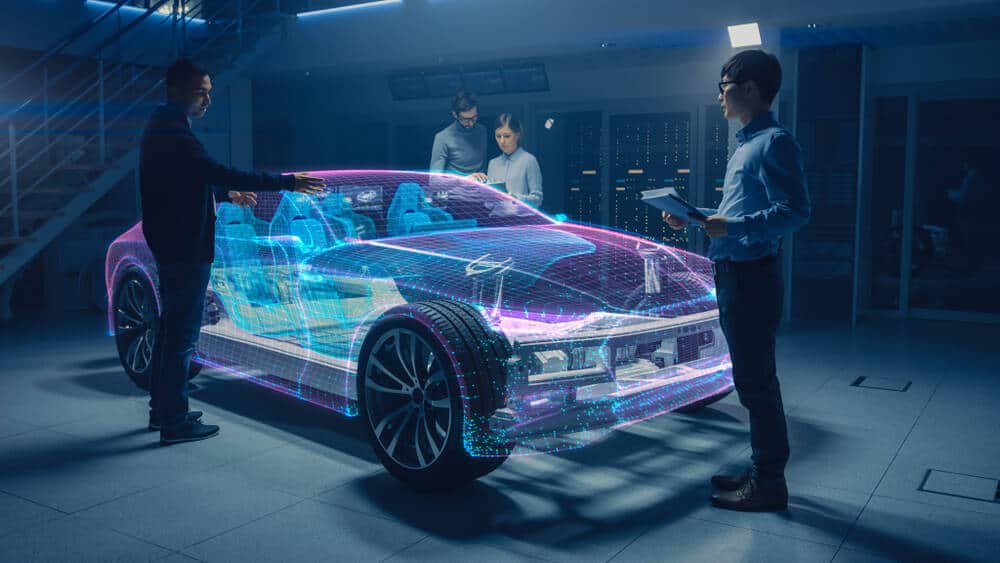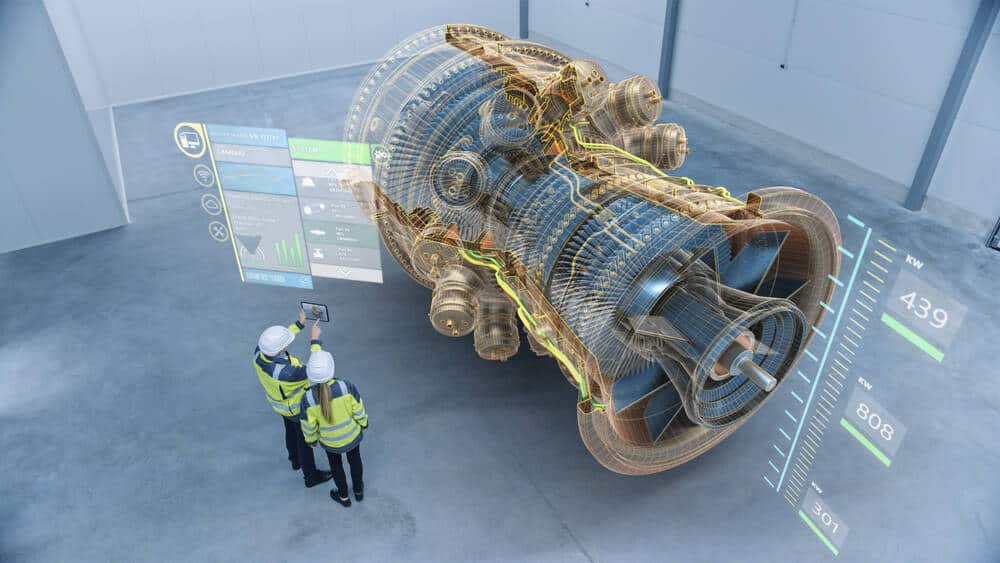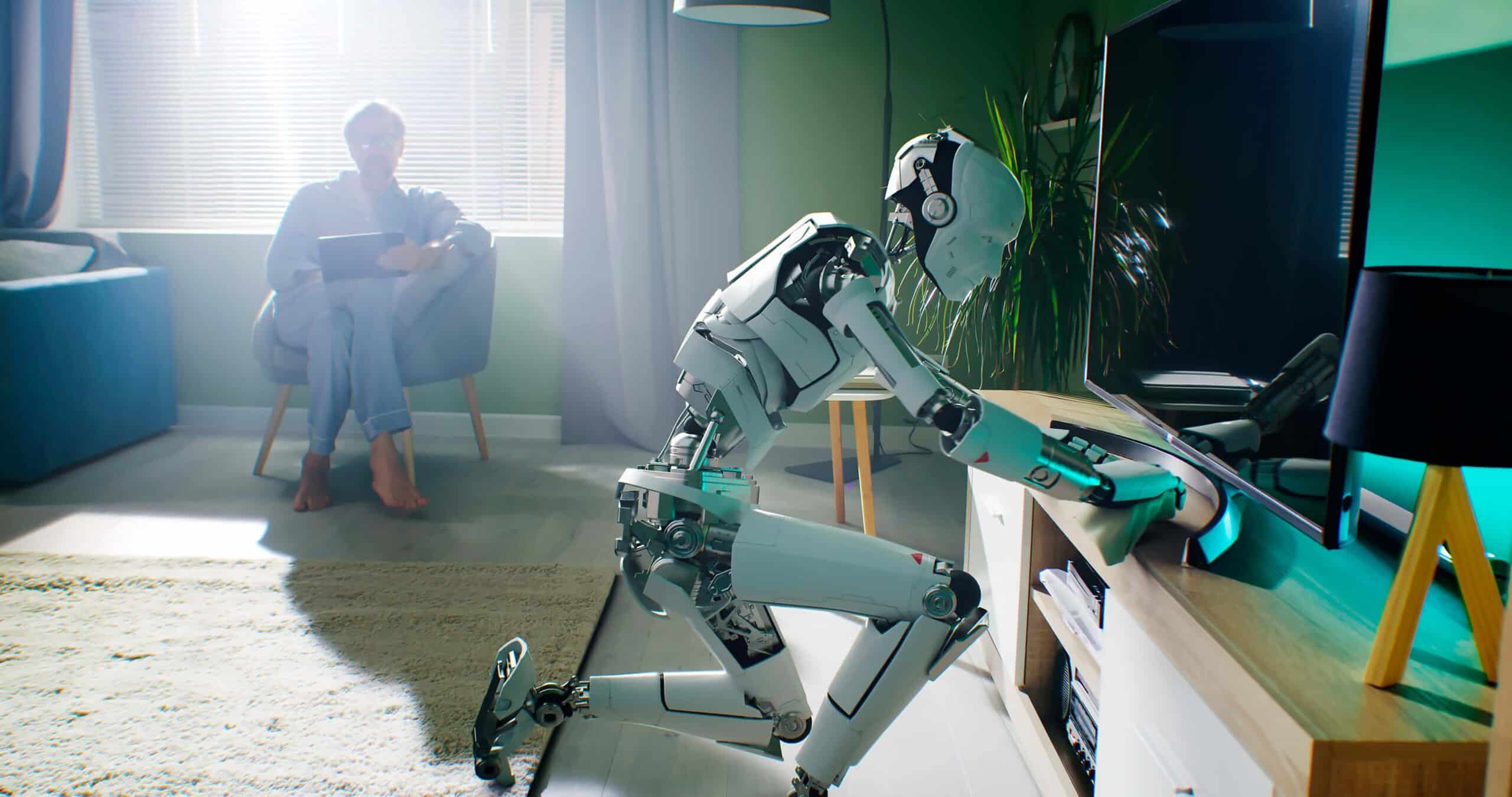- What can we expect from holographic technology?
- What are the different types of holographic technology?
- Star Wars-like holograms coming to a smartphone near you
- Beam your holographic self anywhere in the world
- Medical treatment with floating holograms
- Car dashboards may soon be replaced by holographic displays
- Holograms will become common at the workplace
- Holographic technology is a game-changer
Throughout the history of video gaming and science fiction movies, we’ve seen holograms in all shapes and sizes. In movies like Minority Report and Star Wars, and tv-series like Bones, people manipulate floating images, graphs, and maps, or interact with holographic versions of real – or imagined – people. Holograms are a photographic recording of a light field used to display 3-dimensional images. They can produce the illusion of 3D objects by engaging all four levels of visual perception: binocular disparity, convergence, accommodation, and motion parallax. Holographic technology still seems quite futuristic, but we are much farther along with this tech than you might think. In fact, we can already touch and manipulate holograms.
What can we expect from holographic technology?
Recent developments in holographic technology will lead to the widespread use of holograms in the future, such as in telecommunication, transportation, travel & leisure, manufacturing, and even healthcare. In communication, video conferencing will be spruced up by holograms, enabling us to interact in ways that closely resemble a face-to-face conversation. In travel & leisure, we can expect an increased use of holographic technology as well. Think of museums where a historical figure welcomes visitors, or live concerts with performers who are no longer with us in real life.
In the automotive industry, we can expect holograms to be incorporated into vehicles to enable 3D-representation of GPS addresses or the identification of pedestrians. In healthcare, hologram technology will enable a full 3D visualisation of body parts and internal organs. This will improve medical professionals’ ability to examine injuries and diseases, which will lead to more accurate diagnoses. Holograms can also be used in surgical pre-planning. The tech will enable surgeons to visualise the entire surgical procedure and determine precisely which incisions need to be made to ensure a successful outcome. Another exciting area of application is education. Turning ordinary lessons into interactive digital lessons with holographic images will significantly increase engagement and enable learners to really visualise the concepts that are taught.

What are the different types of holographic technology?
Scientists around the world have developed all kinds of inventive ways to use digital processors, lasers, and motion sensing technologies to create various types of holograms that will transform the way we communicate, learn, experience entertainment, practice healthcare, and more. Here are some of the most notable holographic technologies.
Pepper’s Ghost ‘holograms’
Most people will be familiar with this type of ‘holographic’ technology, as this is the one that’s widely used for performances. This old technology of illusion is named after the English scientist John Henry Pepper (1821–1900), who popularised the technique in which an image is reflected on a transparent screen at a 45-degree angle from a place invisible to the audience, producing a ghost-like result. In addition to his scientific work, Pepper developed many new presentation techniques, using magic and sorcery tricks that he enhanced. The so-called Pepper’s Ghost effect is still the basis for all holograms we see today.
The modern version of Pepper’s Ghost is used in theatres, cinemas, museums, amusement parks, and at concerts. It involves high-end motion capture technology and full 3D CGI to ‘copy’ a person and project them onto a virtually invisible glass pane or high-quality screen. In recent years, the technique has been widely used to ‘resurrect’ megastars like Michael Jackson, Whitney Houston, Tupac Shakur, Elvis Presley, and Frank Sinatra and have them perform on stages around the world. The world’s current leader in holographic technology, MDH Hologram, continues to improve the tech. “Our hologram technology pushes boundaries and expectations, and provides that extra wow factor to captivate your audiences. With our groundbreaking 3D holographic projection technique, your event will never be forgotten.”
Laser plasma holographic projection
The true 3D display technology developed by the Japanese company Aerial Burton Inc. makes use of laser plasma to float 3D images in the air. The technology doesn’t require a screen, water, or fog, to create images; the lasers simply ionise molecules in the air. Aerial Burton director Akira Asano said: “The images are constructed by firing a 1kHz infrared pulse laser into a 3D scanner, which reflects and focuses the pulses of the laser to specific points in the air. The molecules at that point are ionised, and the energy is released as photons.”
The technology is still quite rudimentary and can’t create detailed images like the projection method can. The short light bursts require the projector to continually blast laser beams in order to continue displaying the image. It does demonstrate that it is possible to view light without it first having to bounce off a surface, and could herald a future in which holographic displays in the air become a real possibility. The plasma emission technology could, for instance, be used in communicating important information or directions, such as in the event of an emergency, to inform people about evacuation routes or where to get emergency supplies.
Tabletop hologram technology
The holographic environment Tony Stark has in his workshop in the Ironman movies is still years ahead of our current technological capabilities. But recently, a South Korean research team at ETRI Hologram Technologies made an important breakthrough in that direction by creating the world’s first 360-degree colour tabletop holographic display that can be viewed from any angle. The team accomplished this by using a series of high-powered, multi-colored, lasers and a high-speed rotating mirror display. The technology won the I-Zone Best Prototype Award at Display Week 2020, one of the world’s most renowned conferences on display technologies. Dr. Jinwoong Kim. Principal Researcher at ETRI Hologram Technologies, said: “The 1 μm pixel SLM panel technology is expected to be used extensively since it can be adopted not only for implementation of holograms, but also various ultra-high resolution displays such as micro-display (μLED), augmented reality (AR), and virtual reality (VR), and high-speed communication components and imaging devices.”
Fairy Lights technology
One of the most exciting developments in holographic technology is Fairy Light. A team of Japanese scientists from the Digital Nature Group – including researchers at the University of Tokyo, Nagoya Institute of Technology, the University of Tsukuba, and Utsunomiya University – have come up with a way to create interactive, 3D holograms that are made up of voxels, which are tiny points of light plasma. To achieve this, the team used laser pulses that last just one femtosecond (which is one quadrillionth of a second – or one millionth of one billionth of a second) that can create 3D images with resolutions of up to 200,000 dots per second. And because the plasma bursts are so incredibly fast, you wont get burnt if you touch them. And yes, you can touch, feel, and even walk through them.
Fairy Lights technology can be programmed to shape shift when you physically interact with it. The tiny points of light plasma also create haptic sensations, which means you can actually feel the holograms that float in front of you. According to Dr Yoichi Ochiai, the lead researcher of the team, the sensation is similar to touching sandpaper, while others compare the feeling to static. The responsive nature of Fairy Lights holograms could lead to the technology being applied in entertainment and medical training, and one day even enable scenarios in which we can hug the holograms of friends and family members who are not really physically present.
Now, let’s discuss some examples of how hologram technology could, in the near future, be used or is already being used.
Star Wars-like holograms coming to a smartphone near you
Up until recently, 3D holograms based on the phase shifting holography method could only be captured using a large, specialised camera with a polarising filter. But now, a team of researchers at the Korea Institute of Science and Technology (KIST) and Yonsei University have developed a polarisation image sensor with no additional polarisation filter. Further developments of the tech could lead to the miniaturisation of the entire holographic camera sensor module. What makes this camera stand out, apart from its powerful specs, is its lightweight design and smaller size, which creates possibilities for ordinary digital and smartphone cameras to integrate the ‘photodiode’ technology to accurately place holograms in a real-world environment.
According to Dr Do Kyung Hwang and Dr Min-Chul Park, both researchers at KIST, “The results of our research will lay the foundation for the future development of miniaturised holographic camera sensor modules. The new sensor can further detect near-infrared light, as well as previously undetectable visible light, opening up new opportunities in various fields such as 3D night vision, self-driving, biotechnology, and near-infrared data acquisition for analysing and restoring cultural assets.”
Beam your holographic self anywhere in the world
The LA-based software and technology company Portl was founded by David Nussbaum in 2019. Prior to this, Nussbaum had worked on holograms for movie premieres, mega concerts, and fashion shows. Last year, the company launched its first holographic projection machine, the Epic, measuring 1.5 x 2.1 x 0.6-m. This telephone booth-sized unit enables you to ‘teleport’ to anywhere in the world, or rather, a life-size hologram version of yourself. Even though the company has not disclosed exactly how the unit works, the results are impressive nevertheless. Customers include universities, financial institutions, malls, airports, and more. Nussbaum says: “Eventually the big plan is that they’re everywhere, and when you want to be there, you beam there, like hologram telephone booths.”
“Eventually the big plan is that they’re everywhere, and when you want to be there, you beam there, like hologram telephone booths.”
The unit boasts an AI-enabled camera with a depth-sensing module, stereo speakers, and microphones that enable real-time, face-to-face interaction. The window to which the hologram is beamed has a touchscreen for swipe-and-tap interactions. To date, more than 100 Epics have been installed in over 20 countries across the world and the company is about to release its Portl Mini – a smaller version for desktop use. The Mini (or M) is the size of a mini fridge and can display pre-recorded as well as live hologram teleportations. It also features an AI-enabled camera and integrated speakers, and a high-definition touchscreen display.
Potential applications for these ‘teleportation units’ include digital artwork displays, immersive entertainment, telemedicine, innovative e-commerce features, and more immersive communication. To teleport a person in real time, all that is required is access to the Portl cloud and a smartphone with the Portl Beam app. Nussbaum explains: “It is being used as a communications tool by lots of companies right now. Several of the world’s largest retailers have purchased Portls for pilot programmes. We are also used as virtual assistants, corporate communications and much more. The stuff you saw in Star Trek will be here a lot sooner than we all believe.”
Medical treatment with floating holograms
It’s clear that holographic technology has the potential to completely transform areas like telecommunication, e-commerce, transportation, education, and more. Another area where it could make waves is the healthcare sector. Not only in terms of educational applications, but also for surgery and diagnostics. Rendering 2D images into 3D floating projections will completely transform the way medical professionals plan and carry out medical procedures. Holographic technology will enable doctors to zoom in and out of the images to get a better view of parts that are unclear in the initial scans.
RealView Imaging, a northern Israel-based startup has developed a system, the Holoscope-i, that creates 3D volumetric holograms based on data from medical imaging. The system enables interactive, high resolution and full colour 3D images in free space from any medical 3D volumetric data, and has been especially designed for use in clinical environments like diagnostic clinics, hybrid operating rooms, and interventional suites. The holograms produced by the Holoscope-i float in free space, which enables medical professionals unprecedented access to a patient’s anatomy during invasive procedures. Toronto General Hospital is the first healthcare facility in the world to use holographic imaging in interventional cardiology procedures. RealView has also worked with Philips Healthcare and Schneider Children’s Medical Centre in Tel Aviv during a study on the efficacy of live 3D holographic imaging in a clinical setting.
Kaufman says: “This technology can potentially save many lives, since many times physicians spend a lot of time navigating the patient’s organs without a clear visualisation of their anatomy. In critical operations physicians can, in real-time, locate exactly where they must operate much more independently to save a patient’s life. Better imaging provides, at the end of the day, better clinical results and this is the path that we are working to continue to prove.”
Car dashboards may soon be replaced by holographic displays
WayRay, a Swiss technology company that develops holographic optical systems, complex mechanics, electronics, and software for connected cars, recently introduced its holographic Deep Reality Display that was developed to replace traditional car dashboards. The Deep Reality Display offers drivers an advanced driver-assistance system and entertainment features that enable them to stay focused on the road with minimal distractions. The technology transforms your entire windshield into a virtual realm, displaying necessary information about the car, infotainment, on-ground navigation data, real-time traffic information, and journey and surroundings related content, while simultaneously blending in with the real world to create a safe driving experience. Passengers can enjoy out-of-this-world in-car entertainment, such as games with astounding new levels of immersion, in which passengers become virtual characters that interact with the digitally-augmented real world. The company’s aim is to revolutionise the way drivers and passengers experience the world when looking through any glass surface and transform the driving experience in such a way that vehicles will, in the future, no longer require a physical dashboard.
WayRay founder and CEO Vitaly Ponomarev says: “Deep Reality Display is an extremely important realisation of WayRay’s most cutting edge technologies which will be rolled out commercially and at scale by the beginning of 2023. It is completely reshaping both the driver and the passenger experience, turning moments in our cars into more enjoyable, comfortable and safe adventures. The launch of this technology is an important milestone that brings us closer to our global mission – to make any transparent surface a window into the virtual world.”
Holograms will become common at the workplace
At work we’ll also increasingly interact with holographic technology and holograms will soon become common at conferences, training sessions, workshops, sales meetings, seminars, product launches, and many other events. One company that’s making great strides in this field is WeWork, an American commercial real estate company that provides flexible shared workspaces for technology startups.
The firm wants to enable its tenant companies to make use of HoloPresence for events like panel discussions and presentations to capture and beam remote presenters to real live audiences. The speakers – who are somewhere else in the world, talking in front of a green screen – appear on the stage as life-size 3D holograms that engage with each other and their live audiences. The WeWork location that hosts the event will have a HoloPod on its stage for the holograms to be beamed into. The Holopod resembles a large television screen that’s partly transparent and is equipped with an HD projector, camera, microphone, and audio speakers.
The company has entered into a partnership with Canadian hologram technology company ARHT Media Inc. to implement holographic technology in more than 100 WeWork buildings at 16 locations across the world. Holographic technology can help accelerate the development of the hybrid workplace, in which some employees are present while others beam in a virtual version of themselves from their homes. In comparison to current video conferencing tools like Zoom, where people can’t really see others’ body language and attendants tend to accidentally talk at the same time, holograms enable a much more natural type of remote interaction.
“There’s Zoom fatigue, there’s a lot of friction to being on video all day – it is exhausting. Holograms and avatars enable a new style of communication, where you’ll have better, more frequent interactions.”
“There’s Zoom fatigue, there’s a lot of friction to being on video all day – it is exhausting. Holograms and avatars enable a new style of communication, where you’ll have better, more frequent interactions,” said Brianne Kimmel, founder and managing partner of venture capital firm WorkLife Ventures, a company that specialises in the future of work technologies.
Holographic technology is a game changer
Holographic technology is poised to become a real game changer in many industries and will significantly transform our lives. We’ve only discussed a few examples in this article, but the potential applications of holographic technology are virtually limitless. Think telemedicine, medical imaging, video conferencing, real estate, space research, emergency assistance, architecture and interior design, manufacturing, automotive, digital media, entertainment, education, and many more.
We are headed towards a world in which holographic technology will enable remote users to be represented as a rendered local presence. Think surgeons carrying out remote operations, technicians performing remote troubleshooting and repairs, and hologram renderings improving remote education in classrooms around the world. Another promising future possibility is the ‘haptic internet’, in which holograms are integrated with (emotion-) sensing wearable devices for truly mind-blowing virtual experiences that become increasingly indistinguishable from reality.




